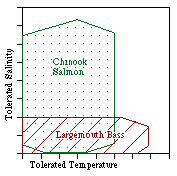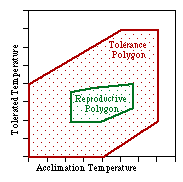

For any environmental factor (e.g. DO, pH, light intensiy, current velocity, etc.) there will be a range which a particular species can tolerate.

An organism with a narrow tolerance range is said to be "steno.." for that factor (e.g. stenothermal or stenohaline). An organism with a wide tolerance range is said to be "eury.." (e.g. eurythermal). Organisms can be steno with respect to one factor and eury with respect to a different one. Centrarchids (bass and sunfish) are eurythermal but stenohaline; salmonids are just the opposite. These tolerance ranges are not independent. An organism near the tolerance limits for one factor will probably be under stress, so its ability to tolerate other factors will be reduced. The tolerance ranges for environmental factors partly define the organism's niche. If salinity tolerance is graphed against temperature tolerance, a niche area is defined.

Graphing a third factor (e.g. pH) at right angles to the first two creates a niche volume. If each of the additional tolerance ranges, including not only the physical factors, but also biotic factors such as food type and predator susceptibility, is graphed at right angles to all the others, the result is (theoretically) an n-dimensional hypervolume as proposed by G. E. Hutchinson as a definition for niche .
The tolerated range shown by a species for a particular factor is not an absolute, as we have seen from the interrelationship between factors. The tolerated range is also affected by the organism's immediate past history; it can tolerate higher temperatures if it is used to (acclimated to) them.

The space defined by all the tolerance ranges for different acclimation temperatures is known as the temperature tolerance polygon. Tolerance polygons are characteristic of the species being considered and may be very different for other species.Tolerance ranges are not completely relative. There comes a point (maximax or minimin) beyond which the organism can not be acclimated. Organisms can acclimate to environmental factors other than temperature even including toxic substances. Presumably for any environmental factor there is a tolerance polygon.
However, tolerances do not remain constant throughout the life cycle of an organism. Tolerance polygons for eggs or juveniles may be quite different than for adults. For most organisms, the conditions under which they can reproduce are much more limited than conditions under which the adults can survive. It is reasonable to visualize a reproductive polygon inside the general tolerance polygon.

Click the Back button to return to the lesson.